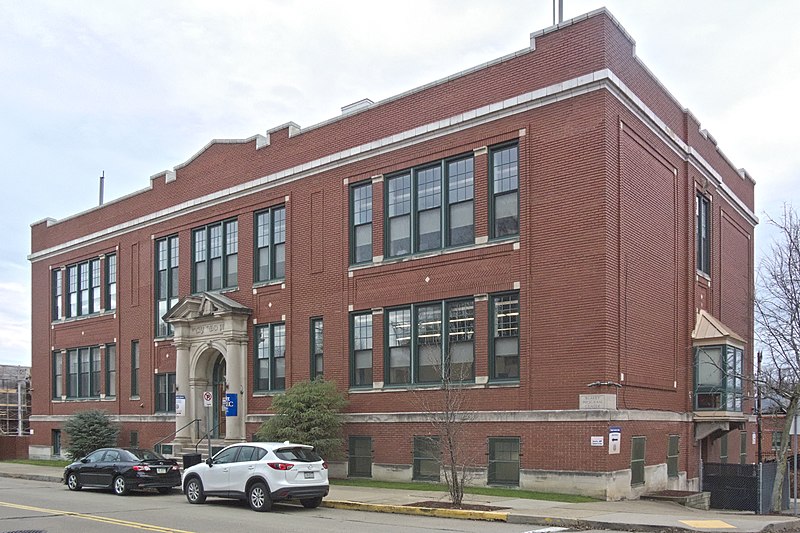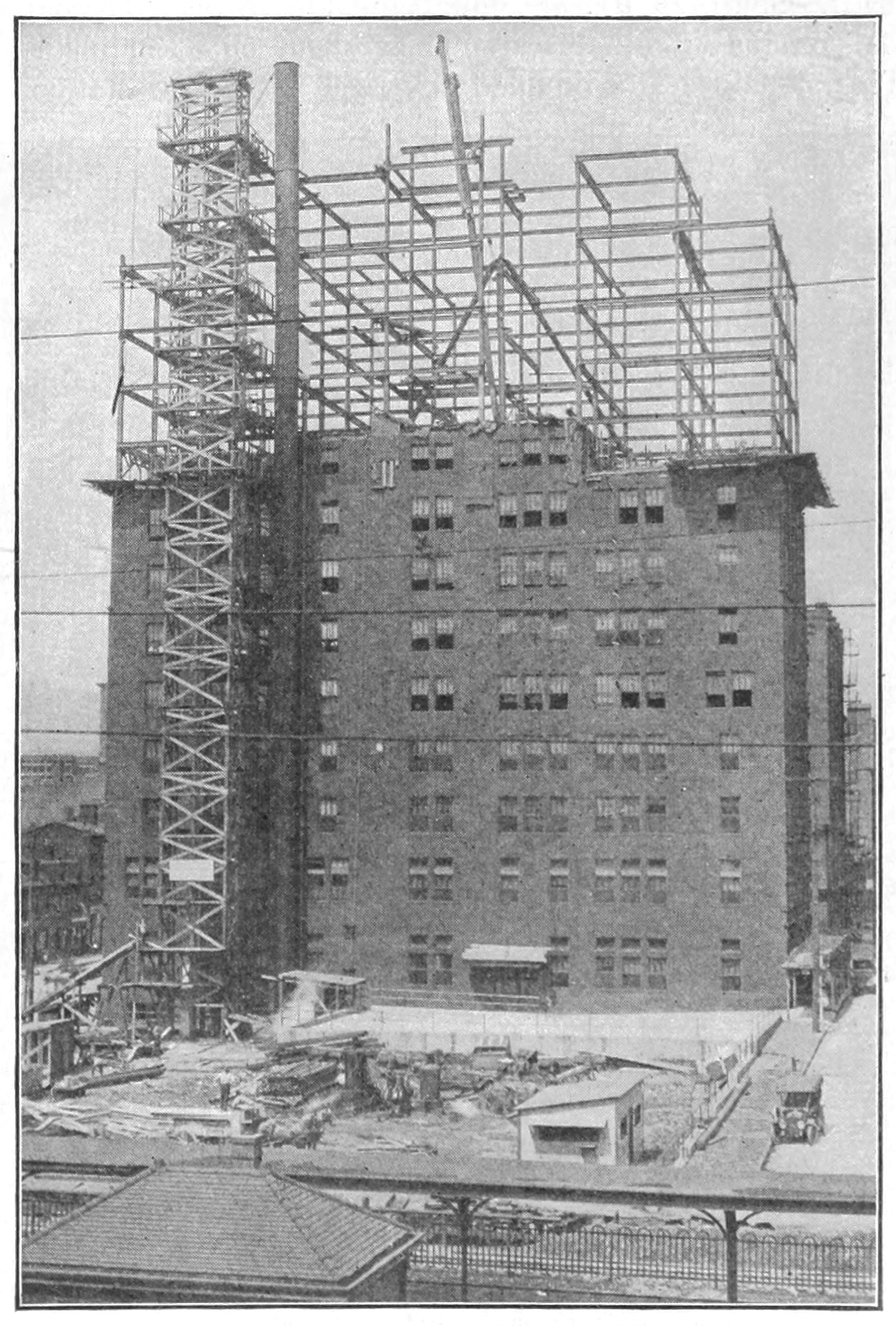
From The Construction Record, September 26, 1914. The building was put up the next year, and still stands almost exactly as Mr. Cohen designed it.


From The Construction Record, September 26, 1914. The building was put up the next year, and still stands almost exactly as Mr. Cohen designed it.

We prefer not to think about it, but the unfortunate fact is that human beings have natural functions that must be attended to. If we attend to them in the street, we will be arrested. The alternative is to go to some place that is privately owned, where we are subject to the whims of the owner.
Our ancestors occasionally attempted to deal with the problem more forthrightly than we are willing to do. From a 1913 magazine:
Two new public comfort stations installed by the county commissioners at the Allegheny County courthouse in Pittsburgh on either side of the Fifth Avenue entrance have been opened for public use. There are two rooms provided, one for women and one for men. They have been finished in white marble and fitted with most modern plumbing appliances.
A rest room for women is furnished with chairs and couches, and the women’s station will be in charge of a matron from 8 a. m. to 11 p. m. Towels, soap, brushes and combs will be found in both stations free of charge. The men’s station will be open at all hours day and night.
With the opening of the new stations Allegheny County will have four public comfort stations in use in Pittsburgh, two on the Federal Street Bridge and the courthouse station.
—Building Age, 1913.

From The Brickbuilder in 1913, two views showing how interior spaces in the Allegheny County Soldiers’ Memorial were illuminated.

An interesting note on the auditorium: In 1960, Syria Mosque across the street was the usual venue for Pittsburgh Symphony performances. But when the Symphony made some high-tech ultra-high-fidelity recordings for Everest that year, conductor William Steinberg insisted on using the auditorium in Soldiers and Sailors Hall instead. He thought the acoustics were much better. Those Everest recordings are still regarded by connoisseurs as some of the most real-sounding symphonic recordings ever made.

Update: Once in a while old Pa Pitt has a chance to boast about his architectural instincts, and here is one of those occasions. In the original article, he wrote that he suspected Edward B Lee of having designed the remodeling of the theater into an office building. He was right. Source: The American Contractor, December 15, 1923: “Store & Office Bldg. (remod. from theater): $150,000. 5 sty. & bas. H. tile. Liberty av. & Strawberry Alley. Archt. E. B. Lee, Chamber of Commerce bldg. Owner The Fidelity Title & Trust Co., Wilson A. Shaw, chrm. of bd., 343 Fourth av. Gen. contr. let to Cuthbert Bros., Bessemer bldg.”
The original text of Father Pitt’s article follows.
Edward B. Lee was the architect of the Liberty Theater—or Theatre, as theatrical people often insist on spelling it—when it was built in 1912. These pictures were published in The Brickbuilder in 1913, so they show the theater as it was when it was new. Either the theater failed or the owners decided it would be more profitable as an office building, because only eleven years later, in 1924,1 it was remodeled into the Baum Building, and it still stands today.

The shell and outlines are the same, but quite a bit was changed externally. Old Pa Pitt suspects that Lee was the architect of these changes, too, and they were accomplished so elegantly that we would never know the building had not been planned that way from the beginning.
These small drawings (orchestra, first balcony, second balcony) show the aggressive adaptations Mr. Lee had to make to the irregular shape of the lot—a common difficulty for buildings on the southeast side of Liberty Avenue, where the two grids of the irrationally rationalistic eighteenth-century street plan collide.

Detail over the entrance. These decorations disappeared when the building was converted to offices.

Corner detail. The cornice and pilasters survive, but the elaborate terra-cotta decoration between the pilasters vanished in 1924.

Henry Hornbostel’s drawing of the south façade of the School of Mines Building, later State Hall. It was demolished in 1973 to make way for the Chevron Science Center, and perhaps someone thinks that was an improvement.
This drawing was published in 1909 in The Brickbuilder, an architectural magazine from which we’ll harvest more illustrations in the future.

The Bureau of Standards wanted to know what caused structural failures in bridges and how to prevent them. So…
A high-carbon steel column under test. Restrained lattice. Buckling of diagonals has begun
This picture comes from the front page of the Engineering News for July 13, 1916. The article explains some of the discoveries made possible by this huge apparatus, and would probably be very interesting to students of engineering.

From the Engineering News for July 6, 1916. Father Pitt knows of no such signs remaining in the city, but he would be delighted to have any remnants pointed out to him.
The use of concrete as material for constructing streetname signs is novel at the present time, but it has proved practicable. Two such signs are shown in Fig. 9. These were designed and installed recently by the Department of Public Works of Pittsburgh. Both post and signboard are of granite-finished concrete. The design shown at the left is modified as a Lincoln Highway marker. The signplates are separate from the post, being so constructed that they swing about a vertical axis and may be clamped at any desired angle. The letters, of a black cement composition of permanent color, are about ⅜ in. thick and dovetailed securely into the concrete of the background.
We’ve mentioned before that the Jones & Laughlin Headquarters Building was expanded upward by five floors almost a decade after it was built. It seems that the expansion was planned and provided for from the beginning, which explains how the architects, MacClure & Spahr, managed it so neatly. The Engineering News for January 18, 1917, gives us the technical details of how it was done, and includes a picture of the back of the building with the construction in progress.

An extension of five stories—planned at the time the structure was erected to its original height of eight stories—has just been added to the Jones & Laughlin Steel Co. office building in Pittsburgh. In the original construction the floorbeams of the ninth floor had been put in place and used to support a temporary roof, and the columns had been provided with splices to take the future extensions. When the addition was begun, holes were cut through the roof to enter the columns, and then these holes were housed around to keep out the rain. A stiffleg derrick hoisted the steel and then erected it.
To give access to the portion of the floor lying between the stifflegs, the loads were temporarily landed at the extreme swing of the boom. The boom was then passed back of a disconnected stiffleg and proceeded with the erection after the stiffleg had been replaced.
The old roof was wrecked as soon as the tenth-floor slabs and the new side walls of the ninth floor were in place. The floor was maintained in a fairly water-tight condition. It had originally been intended to require that the new roof be placed before the old was removed.
All materials other than steelwork, including concrete and débris from the old roof and cornice, were handled in the construction elevator at the rear of the building. Floors were built on the Witherow system, with removable steel centers on which were cast a beam-and-slab floor framing into the steel floorbeams.
McClure & Spahr were the architects, and James L. Stuart was the contractor.

So MacClure & Spahr had to design a building that would look finished at two different heights, which they managed with elegance and finesse. It is now the John P. Robin Civic Building, and the exterior is almost perfectly preserved.
Calvin Coolidge announced that he would not run for a third term in typically laconic Coolidge fashion: “I do not choose to run for President in 1928.” Pittsburgh’s great Cy Hungerford imagines why he might not want that third term. This cartoon came from a microfilm copy of the Post-Gazette; we have made some adjustments to make it look more like what Hungerford originally drew.
For some time now, old Pa Pitt has been gathering information about buildings and their architects in a spreadsheet, so that he doesn’t have to go looking for the information every time he takes another picture. It is still in its early stages, but it already has more than 200 entries. Since it might be useful to other people as well, Father Pitt has decided to publish it:
Father Pitt’s Great Big List of Buildings and Architects
You should be able to download the spreadsheet in Open Document, Excel, or any of several other formats, and you can play around with the spreadsheet without changing the original.